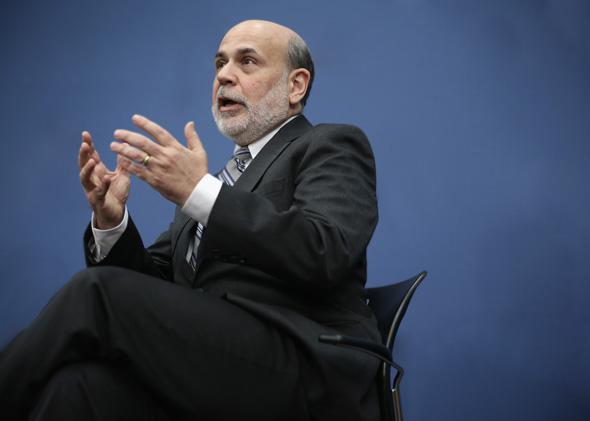New documents released last week by the Federal Reserve shed important new light on one of the most consequential and underdiscussed moments of recent American history: the decision to hold interest rates flat on Sept. 16, 2008. At the time, the meeting at which the decision was made was overshadowed by the ongoing presidential campaign and Lehman Brothers’ bankruptcy filing the previous day. Political reporters were focused on the campaign, economic reporters on Lehman, and since the news from the Fed was that nothing was changing, it didn’t make for much of a story. But in retrospect, it looks to have been a major policy blunder—one that was harmful on its own terms and that set a precedent for a series of later disasters.
Now, five years later, the transcripts from the fateful meeting are available. They confirm entirely that based on the information available at the time, the members of the Open Market Committee should have known better.
The context for the meeting was twofold. On the one hand, the economy was about nine months into what was at the time a modest recession. The housing-price boom of the mid-aughts was over, construction activity had collapsed, and unemployment was on the rise. On the other hand, financial institutions of various kinds had made large bets based on financial models that said a systematic nationwide decline in house prices was impossible. Since just such a decline was in fact happening, many banks were in hot water, and concern about panic was spreading.
Early in the year, the Fed cut interest rates aggressively to try to prevent economic growth from collapsing. Then, come summertime, the bank was paralyzed. Food and oil prices were rising sharply, pushing up overall inflation. Caught between rising inflation and a sinking economy, the Fed did nothing. Then came the Lehman Brothers bankruptcy—the largest bankruptcy in American history, and an unusually disorderly one given the unique attributes of a financial institution. The next day, the Fed’s Open Market Committee had a scheduled meeting and they chose to do … nothing.
In their Sept. 16 statement, the FOMC noted that “strains in financial markets have increased significantly and labor markets have weakened further,” yet they declined to return to rate-cutting.
The full transcript reveals two things. One is that FOMC members were fully aware that the data unambiguously pointed in favor of a rate cut. The other is that the FOMC, somewhat bizarrely, never seriously debated the merits of cutting rates. But David Stockton, the then-head of the research department, told the assembled policymakers that aside from Lehman Brothers “the other notable development over the intermeeting period has been the weakness in the labor markets,” while on the other hand, there were “reasonably encouraging signs on inflation expectations.” Nathan Sheets from the international division added that the “dollar has strengthened nearly 5 percent in broad nominal terms.” Brian Madigan of the monetary affairs division said financial markets were already expecting a rate cut, so standing pat would be seen as “signaling less concern about financial developments than they anticipated.”
In other words, inflation was down, the labor market was down, and the dollar was up. All indicators that looser money was needed. And markets were expecting looser money, so standing pat would send a bad signal.
The remarkable thing is that even as the FOMC’s voting members chose to do nothing, virtually none of them disputed the case for action. Ben Bernanke said “inflation pressures are less worrisome now,” Christine Cumming representing the New York Fed in place of the absent Tim Geithner saw “a downgrade in real activity in the near term since the August meeting,” Sandra Pianalto of the Cleveland Fed agreed that “the commodity price environment has stabilized considerably,” while Fed Gov. Donald Kohn warned that “because of the stronger dollar we will be able to rely less on exports going forward.”
The only contrary evidence produced by inflation hawks was in the form of nonsensical anecdotes. Richard Fisher of the Dallas Fed, for example, swept aside the data to say that “Stein’s Bakery in Dallas, Texas, the best maker of not only bagels but also anything that has Crisco in it, has just announced a price increase due to cost pressures.”
In an actual debate of data versus Texas bagel stories, the data should have won in a landslide. But perversely, the committee spent almost no time debating monetary policy options. Instead everyone agreed to wait and see on monetary policy while mostly focusing their discussion on their view of the Lehman bankruptcy and problems in the banking sector. This was a fascinating topic but, as almost everyone emphasized, one fraught with uncertainties in light of the rapidly developing situation. The basic economic outlook, by contrast, was not fraught with uncertainties. The labor market was definitely getting worse. Inflation and forward-looking inflation expectations were definitely heading down. The dollar was definitely heading up. And at the time the country was not at the “zero bound” or in a “liquidity trap.” An interest rate cut would unquestionably have stimulated the economy.
While it would be a stretch to say that FOMC members were indifferent to the basic economic situation, they were clearly preoccupied with the banking sector. When the stock market tumbled 4.71 percent the day after the meeting and kept falling through the week, the predominant interpretation came to be that policymakers had underestimated the harm done by allowing Lehman to fail, leading down the road to TARP and other bailouts. Another interpretation: They underestimated the harm done by ignoring clear and unequivocal evidence that the situation called for looser monetary policy. Markets were expecting a rate cut. The data pointed to a rate cut. But rates were not cut. Instead the Fed spent a lot of time speculating about the health of the tri-party repo market.
